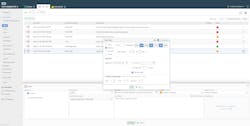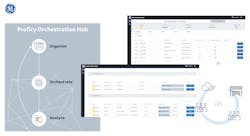Digital Transformation of the Industrial Workforce
While the focus of industry’s digital transformation has largely been on industrial equipment, manufacturers are increasingly turning their attention to automating the flow of information to improve processes. Examining workflow issues at three companies—and how they addressed them—shows how the digital transformation is as much about improving people processes as it is about equipment operation.
Pretium Packaging, a designer and manufacturer of packaging products for the food and beverage, personal care, and medical and consumer industries, has manufacturing facilities across the U.S., Canada, Mexico, and Europe. Many of these plants were acquired, and therefore, Pretium didn’t have a standardized way to share process improvement best practices.
Similarly, Covestro, a manufacturer of high-tech polymer materials, needed a way to seamlessly implement new processes in each of its plant across the globe, even though many of these facilities use different systems to track variations. A key factor of the disconnect in getting new processes effectively implemented across all its plants was an inability to transfer updated information during shift changeovers.
Meanwhile, J.M. Smucker Company was looking to improve its operations’ accuracy and efficiency by effectively combining data from multiple production systems.
Though each of these examples differ, they all depict how companies are working to solve the same workforce issues. Between the great resignation brought on by the pandemic and an industrial skillset shortage, there is a need to equip people with tools that will drive operational efficiency and improve the employee experience.
“Our customers are striving to improve capacity, productivity, and retention,” says Allen Hackman, general manager and global head of the manufacturing industry vertical at ServiceNow, a cloud-based digital workflow platform. “They are dealing with turnover and an aging workforce, and they have a lot of manual processes on the shop floor, which means that many procedures are baked into Excel.”
Hackman says he hears three things from ServiceNow customers. First, they want to remove paper processes from the factory floor. Second, they want to build knowledge into those processes, especially as people need to manage multiple jobs. And third, they want to onboard new workers faster by capturing and transferring the knowledge from experienced workers and retirees.
Lauren Dunford, co-founder and CEO of Guidewheel, agrees. “People have so much valuable information and knowledge and there is an important role [emerging] for getting information from their heads into a consistent and dependable system that can transition into a scalable system rather than ad hoc, one-off problem solving.”
Digital power to the people
For its part, Guidewheel’s FactoryOps platform delivers what it describes as intuitive, out-of-the box workflows. It starts with a sensor that clips around the power cord of any device on the plant floor—regardless of the control system or the age of the machine. That sensor can then pull information into the cloud in real time. “It’s like a Fitbit for the machine,” Dunford says, explaining that it measures the power draw to spot microstops and differences in changeover or process time. As an always-on source of truth, the system is constantly working in the background to alert the right teammates immediately if there is a problem.
“It is the heartbeat of the machine that you can then layer critical information on,” she adds.
That critical information—delivered in real time and in context—could include reasons for downtime, quality issues, actions taken on machine components, labor issues, etc. End users can customize the drop-down menu to their own downtime codes. And using the FactoryOps web interface, which has a mobile component, a plant manager could wake up in the morning and pull up the status of a line to see if a machine is down and adjust the production schedule accordingly.
Pretium Packaging is using Guidewheel to replace that “gut feeling” its workers have used in the past to determine what caused machine downtime with actual data-driven information that provides easy-to-understand information and escalates alerts to the proper people based on the problem the machine is having.
“Before Guidewheel we had to physically go to every machine to figure out why it was down and document it,” says Steve Hernandez, a maintenance manager at Pretium. “Now we are able to react in a more timely manner… and our lives at Pretium have changed as we are now able to get alerts on our phones and react whether we are at home or at work.” In addition, the team can use the Guidewheel charts to see operating trends and take ownership of the machines. “Our team is more engaged and are generally concerned as to why [machines] are down,” he says.
Indeed, having the ability to manage incidents is an important part of empowering operators in a digital-first world.
ServiceNow recently released its Manufacturing Connected Workforce platform which provides maps and visual guides of a facility’s systems and processes, standard operating procedures to help ensure efficiency and compliance, and the ability to capture institutional knowledge on how to deliver best practices.
The ServiceNow platform covers four areas. The first is the standard work that happens every day, which is digitized into checklists of things that need to get done. If a worker doesn’t know how to complete the task on the checklist, they can click on an instructional video to gain knowledge of the procedure. The second piece is exception management, which gives operators the ability to record an incident that drove a specification. Third, if something is wrong, such as an out-of-place safety guard, a worker can trigger an alert that requests some action be taken. Finally, once tasks and workflows are recorded, users can plot trends that help determine why a failure on a machine happened at the time it did.
“The ultimate goal is to improve productivity in the factory; an impediment [to this] has been a lack of knowledge,” says Hackman. “We have a system of action. There are [other systems] that store data, and we sit across the top to be the system of engagement that workers interact with…[to] drive action. We make sure the task gets to the right person, ensure it gets done, and then learn from it.”
At Covestro, which has nearly 17,000 employees, managing shift changeovers requires all key information about the state of the plant systems and processes be evaluated and passed on when the next shift arrives. This is often done with handwritten notes, phone calls, or Excel spreadsheets. The company was looking for a web-based tool that could interface with its SAP ERP (enterprise resources planning) system and was adaptable to varying circumstances at different facilities. What they found was Shiftconnector from eschbach, an interactive shift log developed for the pharmaceutical and chemical industries.
According to eschbach, incidents at process plants are more likely to occur after shift handovers, often due to the lack of digitized documentation from the prior shift. Shiftconnector streamlines communication across a range of operational activities using e-signatures, cross-shift and cross-department task allocation, and the ability to document all shift operations in an auditable way.
In September 2021, eschbach introduced Shiftconnector Go Mobile Rounds, an application that connects field workers with board operators for routine actions and compliance management. In a daily scenario using Shiftconnector Go Mobile Rounds, workers download a task list of specific actions and proceed to specified locations where signoffs on the itemized actions occur. A QR code confirms the position in which the worker is located. As the items on the task list are reviewed, if an anomaly is discovered, such as leakage or a pressure issue, the worker is able to record the adverse event (including photo documentation), which is immediately shared in the shift report via the Shiftconnector platform. The information is then delivered to those responsible for corrective action. Evaluation of the action is recorded to assure compliance. Via the Shiftconnector platform, this information is integrated with shift reporting to alleviate any misinformation or omissions during shift handovers, ensuring compliance, safety, and reliability.
Understanding Data
Collecting data is one thing, having the ability to access and understand it—in context—is something completely different. Seeq analytics software connects, organizes, and contextualizes operations to make data more meaningful. Its process analytics interact with time series data by searching, cleansing, modeling, and finding patterns. “Companies have been collecting time series data for a long time, but accessibility of the data is disjointed throughout the organization,” explains Allison Buenemann, Seeq’s industry principal for the chemical segment.
Seeq analytics can perform root cause analysis and diagnostics and deliver it via a dashboard to the operations level, as well as to engineers and data scientists. For example, there may be calculations and metrics built by engineers that are meant for operators to monitor in real time. “If you have 40 pumps under an area of supervision and you want to know which ones to focus on, Seeq can provide the insight into which ones are performing least well so [the operator] can spend time troubleshooting them,” Buenemann says. “And the first question an operator will ask is: ‘Has this happened before?’ A key strength of Seeq is the ease of event identification so users can look at the data when a problem arises on a unit and then use different methodologies to locate the last time the event happened.”
“It enhances the full workflow beginning with scheduling the inspection, tracking in the field, and finally evaluation,” says Andreas Eschbach, founder and CEO of eschbach. “With mobile capabilities, communication with central operations is enhanced and paper documentation is eliminated resulting in better management of day-to-day plant operations and simpler execution for all involved.”
Uniting Silos of Information
GE Digital set out to solve the problem of disparate data that was causing headaches for its customer, the J.M. Smucker Company, as it relates to identifying and implementing specification changes. As a result of these efforts, GE Digital has released Proficy Orchestration Hub, a set of software tools designed to unify manufacturing product information from disparate systems. According to the company, the software can transform and organize raw business-oriented information into production-ready formats and orchestrate application of the resulting information across factory floor systems.
For example, many manufacturers store quality data in one system, orders in an ERP system, and recipe-related information in a PLM (product lifecycle management) system. These systems are often not connected, therefore someone has to look at all three to assess the impact on the factory floor. Furthermore, supply chain issues can cause production to be out of sync with the latest manufacturing product data, which could result in lower quality or more waste in operations. Proficy Orchestration Hub records, analyzes, and updates manufacturing product data in the plant; it also stores deviations and variances to provide visibility into changes.
“Basically, it is making sure that the shop floor is operating off the right specs for a workorder,” explains GE Digital’s Prasad Pai, senior product manager for Proficy Orchestration Hub. “And when I ask customers how often these changes happen, they say sometimes it happens every couple of months and sometimes it happens every three hours.”
That’s why having easy access to the right information is important—especially when the workforce is changing as fast as the digitized data.



